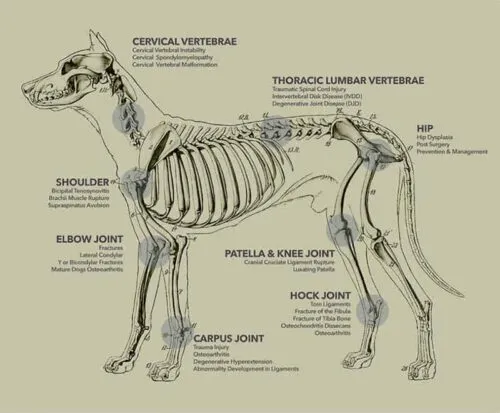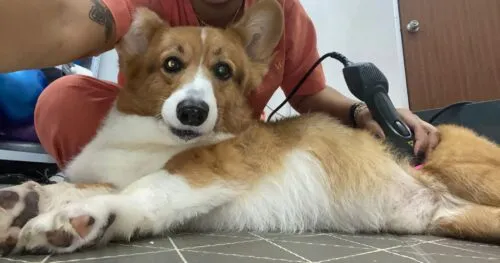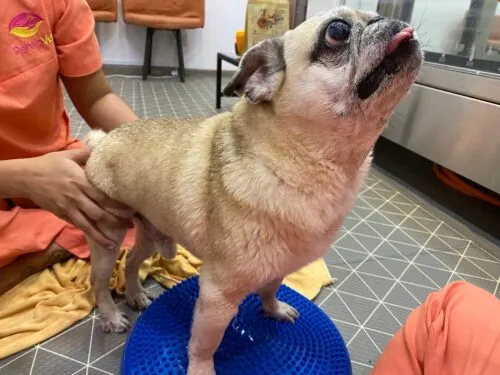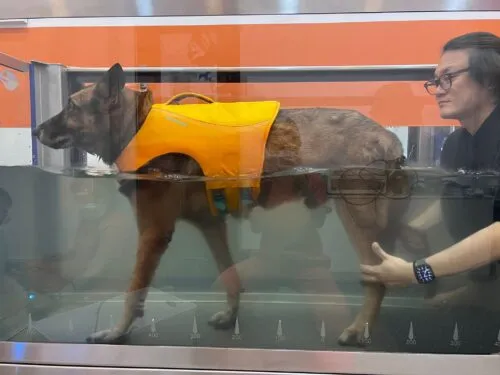EXCELLENTTrustindex verifies that the original source of the review is Google. Scotty (my giant westie boy) pulled his hind right knee as a puppy and 11 years ago, animal rehab wasn’t a widely known therapy treatment among vets, not even the animal bone specialist mentioned it. Eventually arthritis and lots of hobbling and limping caught up, and after consulting our vet (and lots of self research on IG & the internet on doggo rehab in the US), we took a leap of faith based on Google reviews to try RehabVet. 8 sessions in, I’m back full circle to myself give a Google review for them because more pet parents need to know what good work the good folks at RehabVet do to level up the quality of life for our pets! Xan and Sean (and all the assistants, interns) are patient and you can see everyone genuinely loves and cares for the animals. Scotty is treated gently, patiently (he is a stubborn westie after all) and I’m not judged when I ask Xan again and again to teach me how to massage Scotty’s quad and am I doing the exercises correctly 😅 The team know the temperament of the furry patients and when to push Scotty to try a little bit harder, and when to let him rest and we try again next time. Third time’s the charm with the water treadmill - Sean’s the charm, not the peanut butter treat, which says a lot for a pup that is food motivated. He knew a doggo fearful of a new environment meant we had to take things slow, and we did, moving to the bigger pool instead to do leg exercises. Second time no luck with the treadmill, it’s ok we do the pool again, get familiar with swimming. And maybe the third time Scotty’s more receptive of the water filled treadmill, and true enough we hit the jackpot with my furbaby strutting like a boss 🐾🐾 importantly, Scotty has regained mobility 10 odd years of stiffness caused. He’s limping and hobbling less when getting up from rest, he’s even resumed climbing up stairs. It’s an effort that as a doggo pawrent I feel is worth every second and every dime, and I’m glad we are with the warm and genuinely caring team at RehabVet!Posted onTrustindex verifies that the original source of the review is Google. Have been bringing my dog here since 2023, my dog condition improved alotPosted onTrustindex verifies that the original source of the review is Google. Was looking for rehabilitation for my dog who tore his ACL earlier this year and came across RehabVet online and decided to check them out at the pet expo. The therapists were really helpful and sounded experienced in handling such injuries. Decided to sign up for a trial on the spot. After the first session where they did an assessment and some pain management therapies, I was surprised to see almost immediate results. My dog was walking more stable the next day! We proceeded with 10 weeks of rehabilitation which consisted of pain management modalities, exercises and water therapy and he recovered very well. A huge shout out to all the therapists, thank you for helping Orby's recovery and mummy really appreciates your patience with this whining boy 😊Posted onTrustindex verifies that the original source of the review is Google. We’re truly grateful to Dr. Sara, the entire RehabVet team, and especially Xan, who has been exceptionally detailed and patient. The whole team has shown such genuine care throughout Milo’s recovery journey. Milo was diagnosed with IVDD Grade 3 in late June 2025. Although he hasn’t fully recovered yet, we’ve seen significant improvement over the past 3.5 months with pain relief treatments, hyperbaric oxygen therapy, acupuncture, and regular exercise sessions (30 minutes, twice a week). He recently had a reassessment, and the rehab sessions will continue, we’ll now be trying once a month sessions (1 hour each). We believe that slowly but surely, Milo will make a full recovery. Never give up!Posted onTrustindex verifies that the original source of the review is Google. Very patient, detailed and knowledgeable team. My dog feels better after each visit. Taught me massages and exercises for the long term.Posted onTrustindex verifies that the original source of the review is Google. When I first saw my golden retriever unable to lift his head or stand properly due to an old injury, my heart broke. It was painful to watch him struggle, knowing how energetic and full of life he used to be. At first, I was skeptical when I heard about this place—worried it might just be another place that promises a lot but delivers little. But after a few sessions, spaced every two weeks, and hearing the team explain what they hoped to achieve for my dog, I decided to give it a real shot. Now, this has become our monthly routine. My dog receives his therapy, gets regular check-ups, and most importantly, is cared for by a dedicated and compassionate team. The moment I saw him doing zoomies again, with that spark back in his eyes, I knew—it was all worth it.Posted onTrustindex verifies that the original source of the review is Google. My 6.5yo shiba has been having some pain in her hind legs and after diagnosing possible causes including tension in her muscles, the team of therapists gave weekly treatments including machines, massages, strengthening exercises, and swims. The exercises felt targeted and easy to follow and after swims, they help to bathe and dry her as much as they could. Also gave me some tips on how to help my shiba out at home and supplements like Antinol. Scheduling is also quite easy for weeknights over whatsapp/at their counter. After several weeks, my shiba seems better as her hind legs no longer trembles as much when she squats to pee and she hasn’t had episodes of trembling/hiding when she used to get pain in her hindquarters. Hope this progress keeps up for her and that she gets the holistic care and have a pain-free life that she deserves from the friendly therapists at RehabVet!Posted onTrustindex verifies that the original source of the review is Google. Great experience, recommend them!! Joyce and team have been more than caring towards my dog:) and go the extra mile to make sure our appointments are stress-free . super gentle towards a dog that’s very afraid of social settings:) they always ensure that she feels comfortable and safe and I see the difference that Tally can stand better after 1-2 sessions! Just regret that we never came here sooner;))Verified by TrustindexTrustindex verified badge is the Universal Symbol of Trust. Only the greatest companies can get the verified badge who has a review score above 4.5, based on customer reviews over the past 12 months. Read more
Physical therapy: Rehabilitation often involves various physical therapy techniques, such as stretching, joint mobilisation, and therapeutic exercises, to enhance strength, flexibility, and range of motion.
Pain management: Rehabilitative care aims to provide effective pain relief through the use of targeted therapies, such as ultrasound, laser therapy, or acupuncture.
Hydrotherapy: Water-based therapies, including underwater treadmills and swimming, can offer low-impact exercise and resistance training for pets with joint issues or mobility limitations.
Manual therapy: Techniques like massage, myofascial release, and joint manipulation can promote relaxation, improve circulation, and alleviate pain.
Assistive devices: Rehabilitative care may involve the use of braces, splints, or orthotics to provide support and protection during the healing process.
Tailored treatment plans: Animal rehabilitation programmes are customised to address each pet’s unique needs and goals, ensuring a comprehensive and personalised approach.
Preventive care: Rehabilitation can also help identify potential issues before they become significant problems, promoting overall health and well-being.
Enhanced quality of life: The primary goal of animal rehabilitation is to improve pets’ comfort, mobility, and overall quality of life.


1. Improves recovery time: Animal rehabilitation helps to speed up the recovery process by promoting healing and preventing complications. This is achieved through a range of modalities such as hydrotherapy, massage, and therapeutic exercises.
2. Reduces pain and discomfort: Animals that have undergone surgery or suffered an injury can experience pain and discomfort. Rehabilitation can help to alleviate this by providing pain management techniques such as acupuncture, cold laser therapy, and soft tissue mobilization.
3. Enhances mobility and flexibility: Injured animals may experience limited mobility and flexibility. Rehabilitation helps to improve these by employing therapeutic exercises and stretching techniques that increase range of motion, build strength, and improve flexibility.
4. Helps to prevent future injuries: Through rehabilitation, animals can be taught proper movement techniques and given exercises to build strength and flexibility. This helps to prevent future injuries or re-injury.
5. Improves quality of life: Animal rehabilitation can improve the quality of life for animals by allowing them to regain their independence, mobility, and freedom. This can be especially important for animals that are used for work or service, such as police dogs or therapy animals.
1. Assessment – The first step in the rehabilitation process is to assess the animal’s condition. This involves a comprehensive evaluation of the animal’s medical history, current symptoms, and overall health status. The rehabilitation team will work closely with the animal’s veterinarian to develop an individualized treatment plan.
2. Treatment Plan – Based on the assessment, the rehabilitation team will develop a customized treatment plan that may include a range of therapies and interventions. These may include hydrotherapy, massage, acupuncture, cold laser therapy, and therapeutic exercises.
3. Therapeutic Modalities – The therapeutic modalities used in animal rehabilitation are designed to promote healing, reduce pain and inflammation, improve mobility and flexibility, and prevent future injuries. Depending on the animal’s specific needs, the rehabilitation team may use a combination of modalities to achieve optimal results.
4. Hydrotherapy – Hydrotherapy involves the use of water to provide low-impact exercise and promote healing. The animal may swim, walk, or perform other exercises in a water-based environment.
5. Massage Therapy – Massage therapy can help to reduce pain, improve circulation, and promote relaxation. The rehabilitation team may use various massage techniques to address the animal’s specific needs.
6. Acupuncture – Acupuncture involves the insertion of thin needles into specific points on the animal’s body to stimulate healing and reduce pain. This traditional Chinese medicine technique has been adapted for use in animal rehabilitation and has been shown to be effective in treating a variety of conditions.
7. Cold Laser Therapy – Cold laser therapy uses low-level laser light to stimulate healing and reduce pain and inflammation. This non-invasive therapy is often used in conjunction with other modalities.


